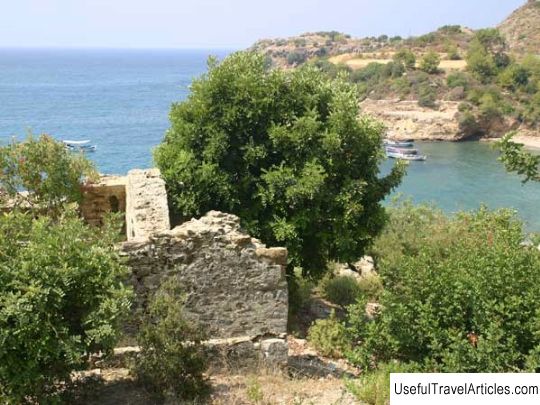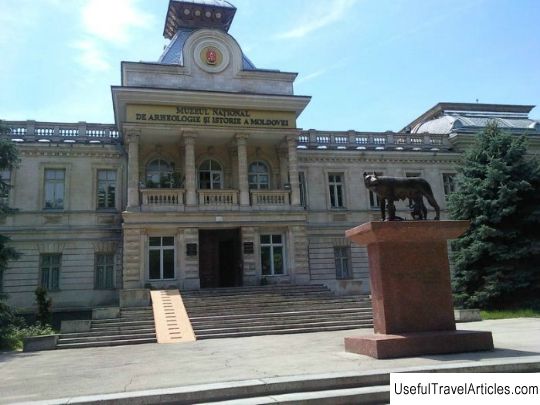Aytap description and photos - Turkey: Alanya
Rating: 7,8/10 (394 votes) 
Aytap description and photos - Turkey: Alanya. Detailed information about the attraction. Description, photographs and a map showing the nearest significant objects. The title in English is Aytap. Photo and description33 km southeast of Alanya, towards the ancient city of Selinus (now Gazipasa), there is a historical harbor, a port city, or as it was also called Iotape estuary city. The old name of this ancient city, which is also common among the local population, is Aytap. The ruins are visible directly from the road - they are located on Cape Kemyurlyuk, in the gorge and on the slopes of the mountains. The city was founded in the II century. BC e., and named, according to historians, based on documentary sources, somewhere in the 1st century. in honor of the wife of the commagene king Antiochus IV Lotape (38 - 72 AD). The area located between Mount Euphrates and Taurus at the beginning of our era. was called Commagena. Here, as a result of the civil war in the 1st century. AD, which became one of the reasons for the destruction of the Seleucid state, an independent state appeared, the first ruler of which was Mithridates I. In this post he was replaced by Antiochus I, whose successor was Mithridates II. So the royal dynasty continued to rule until 72 AD, until the country became part of the Roman province of Syria. Looking closely, you can understand that the ruins of this ancient ancient city belong to the Byzantine and ancient Roman periods. From historical sources that have come down to our times, it is known that for a rather long period in the Roman era - from the reign of Emperor Trajan (38 - 72 AD) to Emperor Valerian (270 - 275 AD), in the city own coins were minted. On one side of it was depicted a bust of the emperor, and on the other - images of such gods as Apollo and Perseus, who were worshiped by people of that time. At the eastern end of the ancient city are the ruins of a temple that was built by Pompey in 111 - 114 AD, as evidenced by the inscription on its wall. The city has a harbor of 50x100 meters. On the plain in front of the gorge that connects the acropolis to the land, there are two paved roads that branch out from the center of the ensemble in an east and west direction. On both sides of these streets, you can still see pedestals, which consist of 3 steps, and pedestals, on which statues once stood in ancient times. Scientists managed to decipher and read the inscriptions on these pedestals, thanks to which it became known that they are about strong athletes, philanthropists and noble citizens who donated funds for the city. The acropolis was located on the high Cape of Kemurlyuk in this ancient city. It served as the center of an ancient settlement and was an elongated structure that stretches towards the sea. The walls of the city, erected for defensive purposes, give the local buildings the appearance of an impregnable fortress. But despite this, the buildings that were in those distant times inside the city walls have practically not survived to this day. All of them are so destroyed that even the layout of the ancient city cannot be determined today. From west to east, along the isthmus connecting the cape with the mainland, passes the central street of the city, decorated with columns. Around the bay, to the east of the acropolis, were the city's religious buildings. One of the best preserved of these is the basilica. "Basilica" in Greek means "royal house" and is a rectangular structure, which consists of three naves, with other rooms attached to it in later times. A small church, which has preserved the amazing beauty of antique frescoes, is located to the northwest of the basilica. Drinking water was delivered to the city from four reservoirs connected to a drain, which was laid from the territory of the necropolis into the gorge. The necropolis in Aytap was located on the hills located in the eastern and northern parts of it. Today, most of the graves of the necropolis have been destroyed, but some of the gravestones and vaulted burial vaults can still be seen. There was also a bathhouse here. Only two vaulted rooms remained from it, however, the most interesting is its sewerage system, which has survived to our times. Archaeologists found that the dirty water coming from the bath was diverted not only through the central canal, which was laid from the gorge directly to the sea, but also through additional canals connected with the main one. The view from the top of the high the hill on which the fortress was built is so beautiful that you simply forget about the difficulties of climbing. Today the ancient city of Aytap is the most easily accessible of all ancient cities preserved in the vicinity of Alanya. It is a great place to relax due to the indescribable beauty of the local nature and magnificent beaches stretching along the seashore. The descent to the sea is quite steep. The terrain here is very rocky and quite rugged, however, to the west and east of these ancient ruins, there are very fertile lands, where today bananas of local varieties are grown using the principles of terraced farming. Visit these picturesque places and not swim in an isolated deserted cove with a sandy beach & nbsp; just impossible. The water here is deeply turquoise in color, because of the rocky bottom it is very clean, on the left is a pile of stones behind which you can hide from prying eyes, lie on a wide stone slab and listen to the sound of the surf until a trance state, catch the splashes from the waves crashing against massive stones. Tourists are also offered excursions to picturesque stalactite caves, which are distinguished by special beauty and charm.      We also recommend reading Hot Springs of Ankara description and photos - Turkey: Ankara Topic: Aytap description and photos - Turkey: Alanya. |




